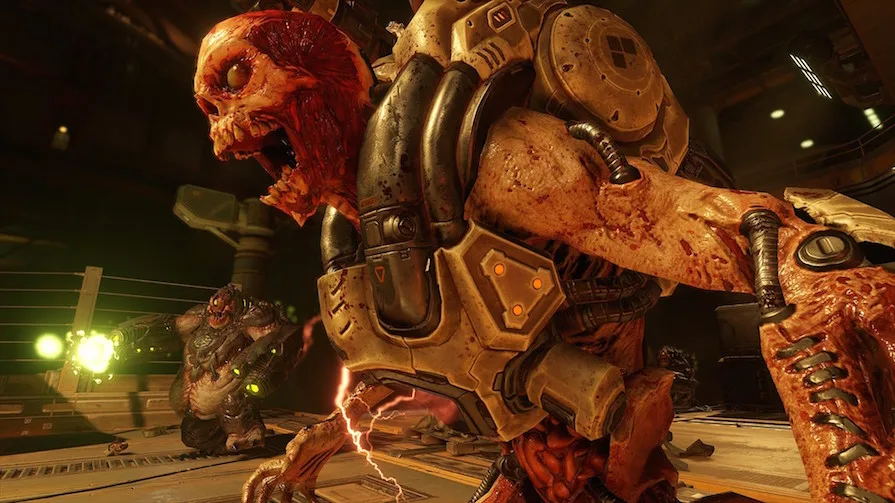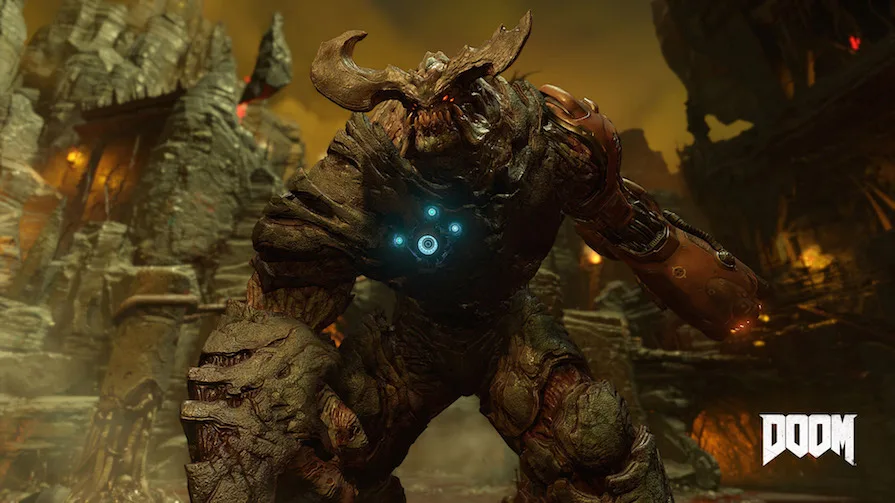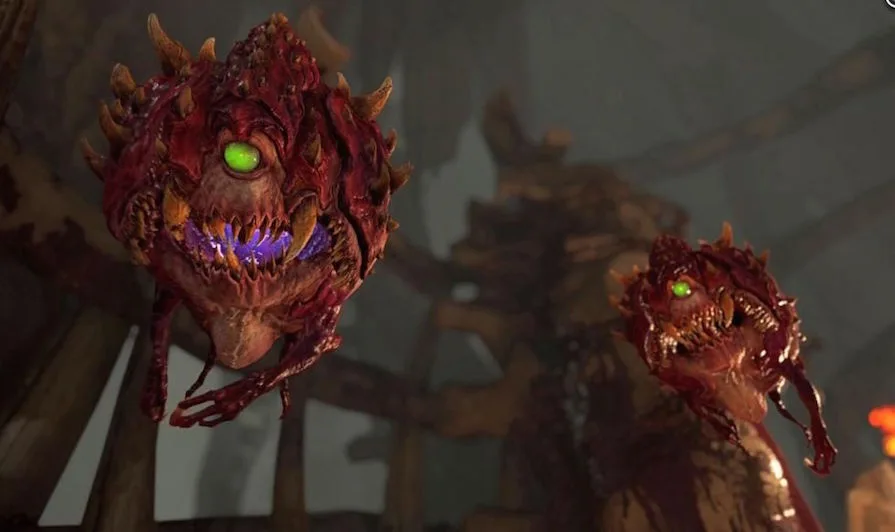Prepare for DOOM with Mars expert Jonathan Clarke
Before you head to Mars in id Software’s Doom Reboot on 13 May, school up on the red planet with expert geologist Jonathan Clarke.
It was 23 years ago tha t an indie developer called id Software changed the gaming landscape forever with Doom, the very first blockbuster in the first-person shooter genre. Now the biggest and most successful category in gaming, the studio is getting back to basics with a reboot, which will be out on 13 May.
The new look Doom is visually spectacular and sounds incredible. It flies along at a blistering pace, too. A real throwback to nineties-era gameplay experiences, you won’t be hiding behind cover and taking potshots at enemy soldier heads from across the map. Nor will you be fiddling with load-outs while you wait to respawn. You will be running, gunning and squeezing that trigger for all it’s worth. A huge arsenal of classics weapons – including the BFG, super shotgun and chainsaw – are at your disposal as you fight back the demons pouring onto the red planet from hell, and ultimately head into Hades itself.
- READ MORE: Uncharted 4: News, interviews and Australian pricing
- READ MORE: DOOM scores a restricted R18+ rating in Australia
A range of multiplayer game types are on offer, too, including the classic four-player deathmatch experience. And a map editor is included – just like the old days – so you can experiment with your own designs and game types with which to challenge friends and the world. Together with the 13-hour campaign, fans of blowing apart big ugly bad dudes with ridiculously overpowered weapons are in for a true treat.
So what better way to get prepared for all the fun than to talk to Jonathan Clarke, president of Mars Society Australia? He graduated as a palaeontologist, moved into petroleum and coal geology, completed a PhD in carbonate sedimentology and palaeoecology, and is now lending his impressive geological know how to better understanding the red planet. What can he tell us about Doom’s setting, and the reality of setting up a military base – and combat – on Mars?

Dr. Jonathan Clarke
- Dr. Jon Clarke is the president of Mars Society Australia
- Jon is a geological general practitioner
- Graduated as a palaeontologist and completed a PhD in carbonate sedimentology and palaeoecology
So how familiar are you with Doom’s legacy and its take on Mars?
JC: I know that Doom has been a landmark game in the history of entertainment and that the impending release of a new version has the potential to have a similar impact on gaming in the future. Beyond that, it’s hard for me as a non-gamer to say. As someone who is interested in Mars and the public’s experience of Mars, I think it’s great that video games such as this - and others out there that deal with the red planet - have the potential to get people thinking of what it might be like to go to Mars and do things there, whatever that may be. It stimulates their imagination. That can only be for the good.
I would put good money on people reaching Mars before the middle of the century.
Realistically, how much of Mars’ surface can we explore before we get there? Do you think we’ll have an accurate read on what’s really down there from what we can see via telescope and probe?
JC: Some of the things on Mars we can see very well. We have mapped the whole surface of Mars from orbit to a scale of 10 metres. An object the size of a suburban house we can see in some detail on Mars already - anywhere on Mars. There are areas on Mars that we have mapped things down to the scale of a dinner plate, but they’re scattered across the Martian surface. We’ve mapped the topography of Mars quite accurately, too. We’ve got ideas on various geophysical properties, so we’ve got a good notion of what Mars looks like from orbit. However, being able to map things is only a small part. What it looks like on the surface we’ve only known from a handful of locations - about half a dozen - where landers have given us a chance to experience standing on the surface.
One thing we have learned about Mars is that it changes dramatically the closer and closer you get. When you look at it from afar, it’s a rather bland, orange ball. There’s not much to see. When you see it at the scale of a few hundred metres down to a few tens of metres, it looks rather moon-like. You see lots of craters and evidence of giant volcanoes and dried up valleys. It’s quite a moon-like world in many ways. When you drop down to a resolution of a few metres, ten times better, suddenly all sorts of strange things start appearing. You begin seeing landslides and gullies, and river fans from former water flows on the surface. You can see complex layering; all sorts of features that were invisible before.
The most detailed view is when you’re actually on the surface and you can see things that are a few millimetres or a few centimetres across. Then Mars becomes an incredibly familiar place that is very Earth-like and suggests it’s a place where we’d feel very much at home if we had the technology to live there.
With that in mind, if people want to experience something as close as possible to life on Mars while here on Earth, where should they go?
JC: Well, there’s still nowhere really like Mars on Earth. In some ways, living in the Antarctic or up in the far north would be like that. The difference, of course, is that on Mars, unless you are at the poles you don’t have permanent darkness or long periods of darkness for a quarter of the year. And then permanent light, or long periods of light, for a quarter of the year. Living in a desert would have some similarities with its lack of water and temperatures, too.
Really you’d have to go live in an enclosed environment that protects you from the hostility of the environment outside to get a true idea. Like what you might find in a submarine. If you could be in a man-made environment that is highly technical and protects you, set in something like an Antarctic wilderness or a desert wilderness, it might give you some idea of what it might be like to live on Mars.
Almost all space-set games and movies are military-driven. How quickly do you think a military presence would end up on a planet or moon colonised by man and why?
JC: That’s a very interesting question, and I think it depends on how - and why – we go to Mars. Most people going to space today have military backgrounds, but they don’t go into space serving as military officers. They go there as test pilots, aerospace engineers or doctors with experience in extreme environments. They have, in their military training, acquired the skills necessary to go there. Many activities at the Earth’s poles in the Antarctic are carried out by military personnel, for example. But just as in space, that’s because they have the skills and the logistic equipment to do it. They’re not necessarily military operations.
In regards to getting military to Mars, you would need to have reasons to compete with or attack your neighbours. At the moment, we can envisage people living on Mars much as we see in the Antarctic - where different countries’ scientists and engineers get on very well together, even though they may be from rival nations who are in competition with each other and the rest of the world. I think that is likely to be the case on Mars as well.
Eventually, if we have permanent settlements on Mars, and those settlements become self-governing, then we may get competition between different towns, which could lead to some kind of conflict. There’s also the possibility within a Mars’ settlement, if it was large enough, that we would see crime and dissidents who might require some kind of police force to keep in hand.
Assuming there is conflict, how would Mars’ atmosphere and gravitational pull impact bullet trajectory on a real on-surface gunfight?
JC: The range of a projectile is determined by how long it takes to fall to the ground and by the air resistance. On the Martian surface, there is very little air resistance, so the range will be greater. Things will fall a lot more slowly, too. We can say then that projectile weapons of the same impulse would be able to fire very much further on Mars than they could here on Earth.

What about jumping and running in comparison to Earth?
JC: We could jump higher and further on Mars because of the low gravity. Although, bear in mind that when you’re outside you would have to wear a spacesuit, which would be very heavy. You’d still be able to jump higher and further than you could on Earth carrying the same amount of mass or weight. In terms of speed, I don’t think that will be affected - but because you have the same mass you do on Earth, but you weigh a lot less, you’d have to be very careful when turning corners. Otherwise, the difference, which you’d not be used to, could catch you out.
How would blood react in Mars’ atmosphere when a human (or demon) is exploded into bits?
JC: On over about half of Mars’ surface, blood exposed to the atmosphere would boil. It would also cool off rapidly because Mars is extremely cold and it’s through boiling that heat is lost. So first of all, it would boil, and then it would freeze. In other parts of Mars, it would stay a liquid - the deeper parts of Mars, where the air pressure is higher. It will stay a liquid until it froze over because it would still be very cold.
What quirks of body design would any native life forms to Mars have to enable them to move, hunt, and defend themselves with maximum efficiency in that atmosphere?If there’s life on Mars today, it’s going to be very small. It will be microscopic, rather like terrestrial bacteria. All the little strategies they use to survive in a hostile environment would have to operate on a small scale. They would have to cope with very low temperatures and very low pressures. They’d have to cope with lots of salts in their environments. They’d have to cope with high radiation.So, you can imagine microbes, for example, that protect themselves from cold by living deeper in the surface where things might be a bit warmer. They might have antifreeze chemicals the way some polar fish have on Earth to stop their body fluids from freezing. They might have DNA that can be repaired very effectively to cope with radiation damage. They may have chemical pumps in their cells that are able to keep pushing salts out so that they don’t get killed by salt flowing in from the environment. All of this would be working on a microscopic scale. If you’re a bacteria, a drop of liquid water hardly big enough to see, would be like an ocean to you. You could have entire ecosystems working on a microscopic scale.

In games we always see these big military bases on Mars, but logistically would those materials need to be sourced on the planet? How challenging would it be to move that kind of material to Mars for construction of large military research bases?
JC: Perhaps only very complex technology might be imported from Earth, like electronics. Eventually, we might be able to make those on Mars as well. It takes a lot of energy to move material from Earth to Mars. You’d want to minimise that as much as possible. What you would take, once you’re past the initial expeditions, would be the equipment that enables you to use Martian resources to make what you need there. There’s no way that we could possibly ship an entire building, which might weigh thousands of tonnes, from Earth to Mars. We’d have to make that out of local materials.
How rich is Mars in the natural resources we use on Earth, and how do you think finding a huge natural resource there and a way to get it back to Earth would impact the race to Mars?
JC: Instead, local resources will be used to build up Martian settlements. What we will find on Mars that might be valuable to export to Earth would be things that we discover there. New products, processes, ideas, scientific theories and software that people develop there and can sell back on Earth. That way they can pay for things they need to import.
Once humans get off-planet in a big way and out into the far reaches of the solar system, what one law of science we take for granted as being true now do you think would be proven incorrect?
JC: No one’s talked about a grand unified theory for several decades now - it’s an embarrassment. There may well be things that we take for granted that, when we go into the universe and we understand much more than our own little corner - about magnetism, how planets form or how life operates - that turn out to be incorrect. One of the reasons why we want to explore is to find out what those things are and get a better understanding.
If you were a betting man, by what year do you think humans would have colonised Mars?
JC: I would like to put good money on people reaching Mars before the middle of the century. I would like to put good money on the fact that we would have permanent stations on Mars by the end of the century. Hopefully, we would have settled Mars by the end of the next one – by which I mean it is settled by people who are being born on Mars and living their entire lives there for generation after generation.

In reality, demons and BFGs aside, what are the top five ways people will die when on Mars?
JC: During the initial expeditions, the most dangerous part of the expedition will be landing and taking off, just like flying on Earth. All the astronauts that have been killed in space exploration to date have been associated with the process of launch or re-entry. Not one astronaut has been killed on the “normal” part of the space mission to date. There were some close calls, but all problems have been fixable. During launch, catastrophic things can happen; during landings, catastrophic things can happen - and very little can be done. Going to Mars will be the same.
The most dangerous part will be landing on Mars and then taking back off. Other hazards of the initial expeditions will be limited medical support relative to Earth. If people get seriously injured or ill from liver failure, cancer, or the like, or even just get burned, there will be very little that can be done except to make them as comfortable as possible. People will die prematurely from accidents and illnesses we regard as treatable on Earth. That’s the price you pay for living and working in a frontier environment.
What about the demon invasion? Surely that will cause a lot of deaths?
JC: Haha, sure.
